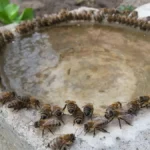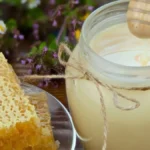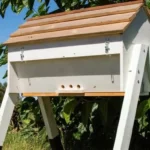In this article, we look at how to ventilate a beehive. Beehive hive ventilation is important to reduce humidity in the hive. Beehive ventilation is particularly important in summer when the bees can develop heat and humidity stress.
Why It Is Important To Ventilate A Beehive
Bees, just like us, breathe oxygen. It is important for them to ventilate a beehive to bring fresh oxygen air into the hive and remove carbon dioxide. If they do not do this, they will suffocate.
Bees generate heat when they are active. Bees keep the brood nest in a beehive at 95°F (35°C). To do this when the weather is cold, they use metabolic heat. The bees flex their muscles to generate heat. When the ambient temperature is higher, it becomes necessary for bees to remove heat from the brood nest.
When bees are making honey, they have to remove moisture from nectar. This moisture creates humidity in the hive. If the humidity is not reduced by ventilation, the honey cannot dry.
It is therefore important to ventilate a beehive to control oxygen levels, temperature, and humidity.
How Do Bees Ventilate A Beehive?
Worker bees create air currents that remove heat from the hive by blowing air out of the hive in one direction. Other bees create air currents that bring fresh air into the hive.
How Do Bees Cool and Ventilate A Beehive During Hot Weather?
If the air temperature is very high, bees cannot cool the hive by moving air around alone. They will collect water from outside the hive and bring the water to the hive. They then spread the water onto surfaces, and fan their wings over this water. The evaporating water cools the surface, and the humidity is then removed by blowing it out of the hive.

Read more about: How Does A Bee Get Oxygen?
I have worked with San hunter-gatherers (Bushmen) in Africa who find beehives in nature by going to water sources on a hot day. Bees fly in a straight line from their hive to water. They watch the bee fly back from the water. Then when she comes back to get more water they take a piece of spider web and tie it to her leg. She flys slowly back to her hive and the spider web helps the hunter track her flight.
On a hot day, the noise made by a hive ventilating itself is a bit like an airconditioning machine, and it is very easy to find the hive. Then it’s time to harvest a little honey. There are few things more beautiful than fresh wild honey on a hot day in Africa.
Beehive Ventilation In Summer
As beekeepers, we try to provide our bees with the best possible accommodation. We are landlords to them – we make them comfortable in their accommodation, and they pay us well in honey. We have already highlighted why summer increases the ventilation requirements of a hive. Now we can look at a few ways we can help our bees ventilate their hives.
There are thousands of different products on the market that aim to ventilate your hives. Many of these are harebrained schemes some beekeeper came up with after drinking too much mead. I like to use simple tried and tested systems, and the following is my favorite.
1. The Ventilated Australian Migratory Bee Lid
This is a simple lid that fits on top of the hive, flush with the side of the box. It is called an Australian migratory lid because it was designed to provide a few inches of space above the combs that bees could cluster in when migrating them on trucks. The lids needed to fit flush with the box so that boxes can fit right next to each other.
In Australia, the insane honey flows produce by Eucalyptus species trees, together with extremely humid summers made these hives essential, and the rest of the world is slowly adopting these lids.
The lid has two to three inches of space between the top of the combs and the inner part of the lid. To ventilate the beehive hive, a few holes 1.5-2 inches across are drilled in the side of the lid, and stainless steel wire mesh is stapled over the holes.
How The Ventilated Australian Migratory Lid Works
This lid allows bees to bring air in through the entrance of the hive at the base, then fan the air up through the brood combs, over the drying nectar in the supers, and out through the top of the hive. This is very efficient.
The bees will put propolis over the wire mesh if they feel they do not need the ventilation and will remove the propolis when they do.
A Bonus Benefit Of Using A Migratory Lid
A bonus of using migratory covers is that during strong honey flows the bees will make a few pounds of delicious honeycomb in the space that the lid provides. The fact that all the humid aroma-rich air from the drying comb in the supers flows over these combs means that the taste of this lid comb is by far the best quality.
2. Off-Center Stacked Supers
During a very strong honey flow, a beekeeper can take the supers and angle them a bit to create open spaces for ventilation. I do not encourage this as it creates opportunities for robbing by other bees and the transfer of diseases. Rather use a migratory lid.
3. Screened Bottom Boards
In extremely humid parts of the world beekeepers sometimes resort to using a screened bottom board. This board allows air to flow in through the base of the hive, and, if used in conjunction with a ventilated lid allows the bees to move huge volumes of air through the brood nest and out of the lid. This can increase honey production.

It is important to keep a close eye on beehives with screened bottom boards as these invite ants and other pests into the apiary.
4. Beehive Ventilation Holes
While using a ventilated migratory lid, we can take a portable drill and a hole saw and drill a few holes in the side of our supers.
Select a hole saw that matches available plastic pipe e.g. three-inch plastic pipe. Drill the hole into the hive and then insert a section of plastic pipe with stainless mesh wrapped over it.
As the season slows down and cools, the bees will propolize the mesh. You can remove the mesh and pipe segment. Insert the piece of wood you cut out and staple it back in place.
Useful Byproducts Of Ventilated Hives
The mesh segments from migratory lids and ventilated supers can be washed with alcohol to remove high-value medical propolis.
Store the mesh and pipe segments for the next season after washing.
I hope you find this article useful – if it has helped you discover a new solution to a problem, please share it. The first time somebody showed me how to make an Autralian Migratory Lid it changed my beekeeping forever.
Read more about: At What Temperature Does Raw Honey Lose Its Benefits?
Beehive Ventilation FAQs
How does proper ventilation benefit a beehive?
Proper ventilation helps regulate temperature and humidity in the hive, ensuring bees have enough fresh air to avoid suffocation and allowing honey to dry properly.
What happens if a beehive isn’t ventilated well?
Poor ventilation can cause excessive moisture buildup, leading to mold growth, brood diseases, and decreased honey production due to high humidity.
How do bees naturally ventilate their hive?
Bees create air currents by fanning their wings, moving hot air out and fresh air in. This process helps regulate both temperature and humidity in the hive.
Can I help bees ventilate their hive in the summer?
Yes, adding ventilated hive lids, using screened bottom boards, or drilling ventilation holes can help bees manage heat and humidity during hot weather.
What are the signs of poor ventilation in a beehive?
Signs include excessive moisture inside the hive, condensation on the lid, and bees appearing stressed or overheating on warm days.
How does a screened bottom board improve hive ventilation?
Screened bottom boards allow air to flow in through the bottom of the hive, enhancing ventilation, especially when combined with a ventilated lid.
What is a ventilated Australian migratory lid?
It’s a beehive lid with drilled ventilation holes covered by mesh, allowing efficient airflow while preventing pests from entering the hive.
Can ventilating a hive increase honey production?
Yes, better airflow helps bees reduce humidity, allowing them to dry nectar faster, which can increase honey production.
Should I leave ventilation open in winter?
No, in colder months, bees require less ventilation as excessive airflow can lower the hive’s temperature, causing the bees to work harder to maintain warmth.
Is it safe to angle supers for ventilation?
While some beekeepers angle supers, this may invite robbing behavior by other bees. A safer alternative is using a ventilated lid or screened bottom board.

Dr. Garth A. Cambray is a Canadian/South African entrepreneur and beekeeper with 28 years of experience in apiculture and specializes in adding value to honey. His Ph.D. research developed a new advanced continuous fermentation method for making mead that has resulted in a number of companies globally being able to access markets for mead. His company, Makana Meadery, exports honey mead to the USA where it is available to discerning connoisseurs. He has also developed technologies to commercially manufacture organic honey vinegar in Zambia for export globally. He holds a few patents globally in the ethanol industry and believes in technology and knowledge transfer for human development and environmental sustainability. One of his proudest achievements is the fact that the wind farm he started at one of his old apiary sites has essentially made his hometown carbon neutral.






